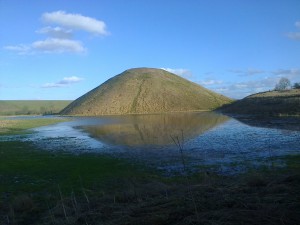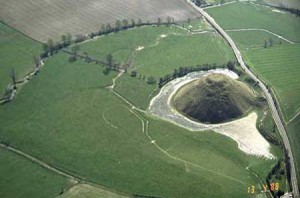John Grigsby is a doctoral student (or doctoral candidate) at Bournmouth University. He is studying “shaping mythology” at British Neolithic sites, under the direction of Professor Tim Darvill. Learn more about John and his work at www.johngrigsby.co.uk.
- Glen
Falling Down the Thames Blog 37, 26th November 2014
Guest Blog by John Grigsby
Anyone wishing to navigate the Thames from source to sea finds themselves having to choose a starting point from a number of possibilities, for a number of tributaries feed into what we now call the Thames – but for ancient man it seems as if the starting point may have been reckoned as the source of the river Kennet in the environs of the monumental landscape of Avebury in Wiltshire.
Avebury is a good choice as a starting point – it is, according to archaeologist Tim Darvill, the furthest point ancient man would have been able to navigate inland from the sea by canoe, and it may be that the monument we now call ‘Silbury Hill’ somehow acted as a marker for this special location.
Silbury Hill is the largest man-made prehistoric mound in Europe, and today it sits beside the road just outside Marlborough like a giant upturned pudding-basin. This mound would have once have been gleaming white from the chalk used in its construction, though we now believe it was created over time not as a single planned monument but as a series of raised mounds added to over time.
The question of why the mound was built has eluded archaeologists, though folklore records it was the tomb of a King Sil, buried in gold armour on horseback, and that it was built in the time it took a posset of milk to boil. Folklore aside many European and Near Eastern myths recall a ‘primal mound’ that at the beginning of time arose from out of the primeval waters of chaos, and it may be that Avebury, with its multitude of springs, was seen as the birthplace of both the river Thames and of creation itself, and that Silbury Hill was symbolic of that first mound of dry earth that rose from the water at the beginning of time. In Egypt this primal mound is known as the Benben and on its summit the Bennu bird, or phoenix, would alight – an occurrence that was mirrored in the temple of Heliopolis where the first light of the rising sun would fall upon the pyramidal BenBen stone at the centre of the temple on New Year’s day.
There are Hindu traditions that talk of the coming of the light of day as the release of the ‘dawn cows’, and the illuminated dawn sky as the milk of the self-same cows. One ancient Hindu ritual sought to encourage the coming of dawn by heating a vessel of milk, which would boil over as a piece of sympathetic magic aimed at helping the sun to rise. Might the folklore of Silbury that speaks of the boiling posset of milk be some echo of a similar rite? Silbury itself contains the element ‘Sil’ which can be linked back to an Indo-European word for sun *Sawilo (the origin of Latin ‘Sol’) but which also seems to be remembered in the name of the spring that lies just beyond Silbury which is known as the ‘swallowhead’ spring.
It is easy to imagine, when stood at the base of the giant mound of Silbury, that our ancestors might have once ascended the summit of the hill in winter, when its base would have been surrounded by flood-water, to light fires and boil milk to encourage the return of the warmth and light of the sun in the spring – and who knows, once the golden light of the early morning sun had struck the mound, maybe they would have travelled along the river, carrying the sacred fire and ‘posset’ of milk; on a celebratory journey all the way along the Thames to the sea?
We are never far away from such pagan musings as we travel along the Thames, whether this be because as we travel we pass over the sites of ancient ritual offerings to the gods of the river, such as the Waterloo helmet or the Battersea shield, or because we recall the strange chapter in ‘The Wind in the Willows’ – called ‘Piper at the Gates of Dawn’ that is nothing less than a paean to the Greek god Pan. To journey along the river is to become a pilgrim on a quest for the place of the rising sun, a journey through history itself. And if Conrad starts his ‘Heart of Darkness’ with a description of the Thames as seen through Roman eyes, as leading into savage, dark, places, we must also remember that the prehistoric source of that same river was not a place of darkness but of creation and light.
- John Grigsby
Photo credit: Aerial view of Silbury Hill, www.archaeologyinmarlow.org.uk



